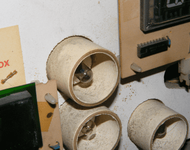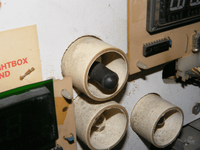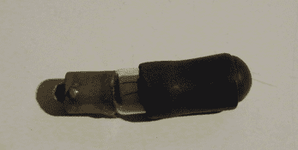1 Introduction
Pinball machines are mechanical devices and will eventually fail to work as designed. This is not to say that pinball machines are fragile as all major pinball machine companies built their games as industrial-grade equipment, specifically designed to take the abuse of being on location. And, over the years, they have far outlived their originally intended service life.
The information in this Wiki should go a long way toward helping you fix and maintain your pinball machine. If there is something unclear on any specific topic, feel free to ask questions in the forums, or post on rec.games.pinball. Frequently, solutions posted on RGP find their way into the Wiki...
2 Other sources of information
The pinball community is blessed with a fantastic group of dedicated hobbyists and parts suppliers.
In addition to here (Of course!) another forum - US based - is www.Pinside.com. A tremendous resource for pinball information is the Rec.Games.Pinball newsgroup archives (https://groups.google.com/forum/#!forum/rec.games.pinball), and Pinwiki (http://www.pinwiki.com).
Another tremendous source is the Internet Pinball Database (IPDB) - http://www.ipdb.org. The IPDB is a great place to research games. The database contains photos, descriptions, history, production counts and other valuable information. The database is an ongoing project with data added continually. The administrator of the IPDB takes great care to ensure that the information contained within is clear and accurate. While not a repair site, the IPDB can provide helpful information with game specific issues. Many machines are documented with both external and internal photos that can assist in restoring or repairing your game. Make this database your first stop when researching a game.
3 Electro-Mechanical or Solid State Games
Pinball machines come in two basic flavours: Electro Mechanical (EM) or Solid State games. EM games can usually be recognized by the score display. EM machines have either light box scoring (lights on the backbox indicate score) or score reels that click over when points are registered. Solid State (SS) games have electronic scoring with either gas plasma displays, or in more recent vintage, dot-matrix displays.
EM machines generally do not have any circuit boards, all scoring and playfield devices being mechanical fired off with relays, switches, and solenoids. Solid state games will have relays and solenoids with all scoring and game rules contained in the circuit boards. SS games can and do have a richer rule set because of the advantages of solid state circuitry. SS games also have more sounds, speech, and music, whereas EM machines are limited to bells and chimes.
During the manufacturers conversion from EM to SS games, some games were released in both an EM and an SS version. The Bally game Mata Hari being an example. Bally produced over 16,000 games in the SS version and only 170 as an EM machine. If you can find an EM Mata Hari, you have a real collectible.
4 Opening Your Pinball Machine
One of the first tasks you need to learn to work on your pinball machine is how to open the front door and remove the glass. Most pinball machines come with a locked front door. Often this key is lost. Before you drill out the lock search around for the key. Look in the backbox if it is open to see if a key is hanging in there. Sometimes the latch on the back side of the lock has been removed and the only thing holding the door closed is the dirt, gunk, or even minor bends in the door itself, so give a bit of a tug on the coin return area to try to open the door before going any further. If you can't find the key and the lock is still intact you will need to drill the lock out to open the door.
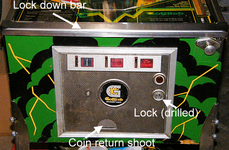
Coin Door of a Gottlieb Machine (Haunted House)
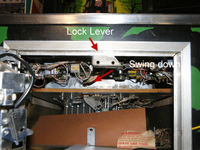
Open Coin Door of a Gottlieb Machine (Haunted House)
Once the door is unlocked or the lock drilled out simply swing it open. If it is stuck, you can put your hand in the coin return slot to get a better grip.
Once you have the door open, look inside and you will notice a bar near the top of the machine. Move the lever down by pushing on it. This action moves a locking bar and releases the lock down bar. If the machine has been setting idle for years it may be difficult to swing the lever from accumulated gunk. One method I have heard to get the bar moving is to tie a weight to the bar and let it hang there for awhile. Eventually, the gunk will give way and the lever moved to the open position. When the lever is in the down position pull up on the lock down bar and remove it from the game. On some games (Chicago Coin and Data East) the lever may be spring loaded requiring you to hold the lever in the open position while removing the bar.
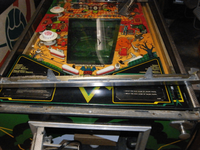
Opened machine
With the lever removed it is a good idea to clean all of the surfaces to prevent more sticking problems. The next step is to remove the glass. One must take safety precautions in removing the glass. Most pinball glass is tempered, some are not. Before I remove any glass I put on heavy work gloves and safety glasses. Before removing the glass have a safe place to put it. I use a thin foam pad to place my glass on and not on a concrete basement floor. If moving the glass across the room make sure the path from the machine to the glass storage area is clean with no obstacles on the floor that you could trip on.
Start by placing your hands on the glass and sliding it out along the track. You could have more gunk in the track making sliding the glass difficult. I have also encountered machines where the cabinet is not square, putting pressure on the glass and making it difficult to remove. If the machine was dragged across the floor, which puts pressure on the legs, the cabinet could be out of square. Use the Armstrong lifters to raise and lower the machine to hopefully put it back on square, at least some.
Once you have moved the glass somewhat you can push it from the upper part of the playfield. Proceed with caution and remove the glass and place it aside. You now have access to the inners of the lower cabinet and can start to make repairs.
5 Cleaning Your Pinball Machine

Not much Novus #2 is needed when cleaning a playfield
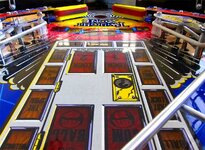
Before and after cleaning with Novus #2 and naptha
It is generally accepted to use Novus #2 to clean your playfield. Under no circumstances should you use Windex or any other glass cleaner on your playfield. In the past manufacturers recommended a product called Wildcat or Mill Wax but both have been shown that they could damage the playfield paint. Novus is a general plastic cleaner that can be found from any pinball parts supplier, The Container Store, or possibly a local auto parts store. It is the recommended cleaner by most if not all pinball manufacturers. You can additionally apply a layer of pure carnauba wax as an extra layer of protection after cleaning the playfield.
Novus should also be used to clean playfield plastics. Novus makes three grades of cleaner (#1, #2, and #3) with varying grades of abrasiveness. Novus #2 should be all you need but Novus #3 can be useful for plastics that are very dull. Use care when cleaning the printed side of the plastic. You should never use Novus #3 on your playfield.
If your playfield rubber is dry and cracked it should be replaced. Kits to replace all rubber on a machine are available from all of the pinball suppliers. Rubber that is is good shape but dirty can be cleaned with Naptha or lighter fluid.
You can safely clean the cabinet with a product like Simple Green or Goo Gone. Be sure to test the cleaner in an inconspicuous area first to make sure no paint is removed. Different eras of machines are more susceptible to have paint removal.
6 Fuses
All pinball machines have fuses. Fuses are used in the machine to protect the internal components from damage in the event of an electrical short. If you have turned on the machine and did not get the expected result, check for blown fuses. Remember that a blown fuse is usually an indicator of an electrical short. You will need to find the cause of the short to bring the machine back to full working condition. The fuses in a machine all guard a particular section or voltage. One fuse may be for score displays while another is for solenoids and still another for the general lighting.
In replacing a fuse always make sure you are using the correct value, or amperage. The amperage of a fuse is stamped on the one of the electrical contacts of the fuse. DO NOT assume that the fuse in the machine is the value that should be used, always check the game manual or schematic to verify the correct rating. Someone repairing the game earlier may have put in a higher fuse value to circumvent an electrical problem. Do not swap out fast acting fuses for slow blow fuses, always use the correct rating and type.
Fast blow fuses can be easily checked visually, not so for slow blow fuses. Fast blow fuses, when blown, usually have a scorched appearance and the internal wire will be severed. Slow blow fuses will be intact. Close, visual examination will reveal that the rope looking conductor is twisted and shows defects when blown. The best way to check a slow-blow fuse is with a multi meter set to resistance mode. Place the probe on each side of the fuse. A slow-blow blown fuse will have a very high resistance, in the mega-ohm range.
Fuses can be located anywhere within the game. Often there is a bank of fuses in the bottom cabinet. Other fuses may be located on the underside of the playfield and more in the backbox. In solid state games, fuses can also be found on the individual circuit boards. Each fuse should have a label next to it indicating which fuse it is for reference in the schematic and game manual. Sometimes these labels have gone missing in the machine. If this is the case in your machine, mark the the board next to the fuse with a "sharpie" when you have correctly determined its label. It is also a good idea to write down the rating of the fuse next to the label.
Pinballmania and Pinball heaven carry a good deal of fuses and values, alongside many places on eBay. When needing fuses, these are good places to start. Always have a good stock of fuses on hand in your parts drawer.
Sometimes fuses can be difficult to remove from the machine. You can gently pry them free with a small screw driver, being careful not to pry on the glass part of the fuse, but instead on the metal sides. Insert the small screwdriver under the fuse in the fuse holder and pry. If you find that the fuse holder no longer has much spring, it needs to be replaced as it will not make good electrical contact. This can cause intermittent problems, which are the hardest to find.
7 Batteries
Batteries are the bane of electronic pinball machines. They are used to keep semi-conductor memories active, so things like high score and game settings are maintained while the power is off. Over time, they leak, and the battery acid (really a base, but let's not go there), oozes onto the electronic circuit board destroying the etches and components. Typically, when the batteries die, various error messages appear like a "factory settings restored" message when the machine is turned on.
Williams and Data East games use AA (LR6) batteries, which should be replaced yearly. However, the best thing you can do is remotely mount the batteries, so if they do leak, they will not damage the circuit board.
8 Lamps
Lamps are used throughout the machine to indicate game features, scoring, and to light the playfield. Lamps that illuminate the pinball playfield and backglass that are not part of the scoring are called General Illumination (GI) lamps. These lamps run on their own circuit and fuse and typically run around 6.3v AC.
As machines age, the lamps burn out and need replacement. Most lamps in a pinball machine are type 44 as installed at the factory. The 44's run hot and can cause burning over time to the adjacent wood or plastics. These can be replaced with type 47, which run cooler. Type 44 bulbs are brighter than the type 47.
It is at the discretion of the reader, but some people prefer to use 44 lamps under playfield lamp inserts. 44 lamps are brighter, and tend to stand out better while playing the game.
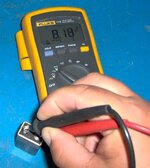
Making certain an old 9v battery is putting out an acceptable lower voltage
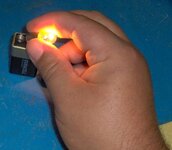
Testing a 6v bulb with a dying 9v battery
As mentioned previously, most bulbs used in any game are powered by ~6 volts. A great way to quickly test a bulb is to use a dying 9v battery. Don't use a fresh 9v battery, or you will shorten the life of the bulb. Find a battery that is roughly putting out 7v - 8.25v. An old battery from a smoke detector works pretty well.
Place the tip of the bulb on one of the battery terminals, and cock the outer metal casing of the bulb to touch the other terminal. Orientation of the bulb with regards to the positive and negative terminals does not make a difference in this case. Do not hold the bulb across the battery terminals for very long. Just long enough to determine if the bulb's filament is lighting or not.
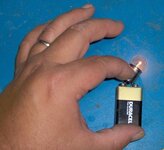
Testing a flasher bulb
Flasher bulbs can be tested the same way, however, a fresh 9v battery should be used.
When replacing bulbs they often can be difficult to remove due to their location. Lamps under the playfield can be removed by bending the lamp holder back to get access to the bulb. Burnt out lamps on the top side of the playfield can be accessed by removing the overlaying plastic piece. To remove really stubborn lamps, or ones that you can not grab use an old shooter tip. Place the shooter tip over the bulb and push and twist it out, installation is a reversal of removal.
Another great and cheap removal tool is a small, approximately 3" - 4" piece of clear vinyl tubing. The same process in using a shooter tip applies.
CAUTION: when removing bulbs, have the game turned off. Having it unplugged is even better in some instances. Keep in mind that most bulbs are constructed of half glass and half conductive materials. If a bulb is accidentally dropped during removal or installation, a 50% chance of the bulb shorting across objects it falls onto is there.
It is also a good idea to get a lamp socket cleaning tool. This tool is inserted into the lamp socket and rotated about to clean the socket connection. Some lamps and sockets can develop corrosion that needs to be cleaned or the socket replaced.
9 Coils
Coils are used in pinball to convert electrical energy into mechanical motion. Coils have been an integral part of pinball since 1933. They are used in pinball games in three different forms. 1. Relays - The coil is used to operate a switch. Used mainly in electro-mechanical (EM) games. 2. Solenoid - The coil is used to move a plunger which in turn moves a mechanical device. 3. Magnets - Used in newer games to divert or capture the ball.
9.1 Top 5 things to know:
The correct coil number is usually listed in the game’s manual and for EM games it is usually marked on the schematics. Some coils will have numbers of the form X-25-850-Y, where 25 is the wire gauge and 850 is the number of turns. The prefix X and suffix Y usually indicate the form the coil is wound on, the lug orientation, and possibly the length of the coil sleeve. Gottlieb coils do not follow this scheme and you must refer to a coil chart to determine the wire configuration.
The coil bobbin used for most Bally/Williams solenoid coils has places for three terminal lugs; left edge, middle, and right edge. The AL has lugs on the left and middle (Left), the AE has lugs on left and right (Ends), and the AR has lugs on the right and middle (Right). The positions are as viewed with the lug end of the coil facing you and the lugs facing upward.
9.3 Coil Strength
The strength of a coil is determined by the current through the coil, the number of turns or wire, and the dimensions of the coil. One representation of the strength of an electro-magnetic coil is magneto-motive force, given as: MMF = N * I where N is the number of turns of wire on the coil and I is the electrical current through the coil. Increasing the number of turns (at a fixed current) or increasing the current will increase the strength of the coil.
Removing turns of wire to strengthen coil. This is counter-intuitive at first, but removing wire from a coil makes it stronger. This is because the reduction in wire resistance has a larger impact than the number of turns. Less resistance results in larger electrical current and hence increased coil strength.
9.4 AC vs. DC
Coils do not have polarity. This may also be counter-intuitive, but a solenoid pulls the plunger INTO the coil regardless of the direction of current through the coil. This is why a solenoid can operate on alternating current (AC). Since a coil is an inductor it resists changes of electric current, a property known as reactance. Reactance can be thought of as increased resistance when the coil is driven with AC. The lack of reactance increases coil current and thus the coil strength when driven with DC.
A coil of wire is an inductor, an electrical component that resists any change of electric current. Inductors also store energy in their magnetic field. Fast changes in electric current create an electromotive force (EMF) from this stored energy that opposes the current change. Due to this opposition it is often called back-EMF. The largest change in current occurs when the coil is switched off and the back-EMF can create a high voltage spike of thousands of volts. In EM games, this voltage spike can result in arcing across the switch. In SS games, a diode is used to snub the voltage down to levels safe for the drive transistor.
9.5 Coil Diodes
SS games use a diode to prevent the back-emf induced voltage from damaging the drive transistor. The diode must be installed correctly, so if you are replacing a coil be sure the wire colour on the banded end of the diode is the same on the new coil as it was on the old coil. The banded end of the diode must connect to the positive coil voltage. Typically, EM coils are driven with AC voltage and must not have a diode on the coil.
9.6 Coil Mounting
The primary consideration when orienting a coil during installation is avoiding any nearby objects that the coil or coil lugs could hit and possibly short out. Beyond that, there is an argument that it’s better to orient the coil with the lugs at the opposite end of the coil stop with the belief that it will lessen the vibration and reduce the chance of the wires breaking off.
Pinball machines are mechanical devices and will eventually fail to work as designed. This is not to say that pinball machines are fragile as all major pinball machine companies built their games as industrial-grade equipment, specifically designed to take the abuse of being on location. And, over the years, they have far outlived their originally intended service life.
The information in this Wiki should go a long way toward helping you fix and maintain your pinball machine. If there is something unclear on any specific topic, feel free to ask questions in the forums, or post on rec.games.pinball. Frequently, solutions posted on RGP find their way into the Wiki...
2 Other sources of information
The pinball community is blessed with a fantastic group of dedicated hobbyists and parts suppliers.
In addition to here (Of course!) another forum - US based - is www.Pinside.com. A tremendous resource for pinball information is the Rec.Games.Pinball newsgroup archives (https://groups.google.com/forum/#!forum/rec.games.pinball), and Pinwiki (http://www.pinwiki.com).
Another tremendous source is the Internet Pinball Database (IPDB) - http://www.ipdb.org. The IPDB is a great place to research games. The database contains photos, descriptions, history, production counts and other valuable information. The database is an ongoing project with data added continually. The administrator of the IPDB takes great care to ensure that the information contained within is clear and accurate. While not a repair site, the IPDB can provide helpful information with game specific issues. Many machines are documented with both external and internal photos that can assist in restoring or repairing your game. Make this database your first stop when researching a game.
3 Electro-Mechanical or Solid State Games
Pinball machines come in two basic flavours: Electro Mechanical (EM) or Solid State games. EM games can usually be recognized by the score display. EM machines have either light box scoring (lights on the backbox indicate score) or score reels that click over when points are registered. Solid State (SS) games have electronic scoring with either gas plasma displays, or in more recent vintage, dot-matrix displays.
EM machines generally do not have any circuit boards, all scoring and playfield devices being mechanical fired off with relays, switches, and solenoids. Solid state games will have relays and solenoids with all scoring and game rules contained in the circuit boards. SS games can and do have a richer rule set because of the advantages of solid state circuitry. SS games also have more sounds, speech, and music, whereas EM machines are limited to bells and chimes.
During the manufacturers conversion from EM to SS games, some games were released in both an EM and an SS version. The Bally game Mata Hari being an example. Bally produced over 16,000 games in the SS version and only 170 as an EM machine. If you can find an EM Mata Hari, you have a real collectible.
4 Opening Your Pinball Machine
One of the first tasks you need to learn to work on your pinball machine is how to open the front door and remove the glass. Most pinball machines come with a locked front door. Often this key is lost. Before you drill out the lock search around for the key. Look in the backbox if it is open to see if a key is hanging in there. Sometimes the latch on the back side of the lock has been removed and the only thing holding the door closed is the dirt, gunk, or even minor bends in the door itself, so give a bit of a tug on the coin return area to try to open the door before going any further. If you can't find the key and the lock is still intact you will need to drill the lock out to open the door.

Coin Door of a Gottlieb Machine (Haunted House)

Open Coin Door of a Gottlieb Machine (Haunted House)
Once the door is unlocked or the lock drilled out simply swing it open. If it is stuck, you can put your hand in the coin return slot to get a better grip.
Once you have the door open, look inside and you will notice a bar near the top of the machine. Move the lever down by pushing on it. This action moves a locking bar and releases the lock down bar. If the machine has been setting idle for years it may be difficult to swing the lever from accumulated gunk. One method I have heard to get the bar moving is to tie a weight to the bar and let it hang there for awhile. Eventually, the gunk will give way and the lever moved to the open position. When the lever is in the down position pull up on the lock down bar and remove it from the game. On some games (Chicago Coin and Data East) the lever may be spring loaded requiring you to hold the lever in the open position while removing the bar.

Opened machine
With the lever removed it is a good idea to clean all of the surfaces to prevent more sticking problems. The next step is to remove the glass. One must take safety precautions in removing the glass. Most pinball glass is tempered, some are not. Before I remove any glass I put on heavy work gloves and safety glasses. Before removing the glass have a safe place to put it. I use a thin foam pad to place my glass on and not on a concrete basement floor. If moving the glass across the room make sure the path from the machine to the glass storage area is clean with no obstacles on the floor that you could trip on.
Start by placing your hands on the glass and sliding it out along the track. You could have more gunk in the track making sliding the glass difficult. I have also encountered machines where the cabinet is not square, putting pressure on the glass and making it difficult to remove. If the machine was dragged across the floor, which puts pressure on the legs, the cabinet could be out of square. Use the Armstrong lifters to raise and lower the machine to hopefully put it back on square, at least some.
Once you have moved the glass somewhat you can push it from the upper part of the playfield. Proceed with caution and remove the glass and place it aside. You now have access to the inners of the lower cabinet and can start to make repairs.
5 Cleaning Your Pinball Machine

Not much Novus #2 is needed when cleaning a playfield

Before and after cleaning with Novus #2 and naptha
It is generally accepted to use Novus #2 to clean your playfield. Under no circumstances should you use Windex or any other glass cleaner on your playfield. In the past manufacturers recommended a product called Wildcat or Mill Wax but both have been shown that they could damage the playfield paint. Novus is a general plastic cleaner that can be found from any pinball parts supplier, The Container Store, or possibly a local auto parts store. It is the recommended cleaner by most if not all pinball manufacturers. You can additionally apply a layer of pure carnauba wax as an extra layer of protection after cleaning the playfield.
Novus should also be used to clean playfield plastics. Novus makes three grades of cleaner (#1, #2, and #3) with varying grades of abrasiveness. Novus #2 should be all you need but Novus #3 can be useful for plastics that are very dull. Use care when cleaning the printed side of the plastic. You should never use Novus #3 on your playfield.
If your playfield rubber is dry and cracked it should be replaced. Kits to replace all rubber on a machine are available from all of the pinball suppliers. Rubber that is is good shape but dirty can be cleaned with Naptha or lighter fluid.
You can safely clean the cabinet with a product like Simple Green or Goo Gone. Be sure to test the cleaner in an inconspicuous area first to make sure no paint is removed. Different eras of machines are more susceptible to have paint removal.
6 Fuses
All pinball machines have fuses. Fuses are used in the machine to protect the internal components from damage in the event of an electrical short. If you have turned on the machine and did not get the expected result, check for blown fuses. Remember that a blown fuse is usually an indicator of an electrical short. You will need to find the cause of the short to bring the machine back to full working condition. The fuses in a machine all guard a particular section or voltage. One fuse may be for score displays while another is for solenoids and still another for the general lighting.
In replacing a fuse always make sure you are using the correct value, or amperage. The amperage of a fuse is stamped on the one of the electrical contacts of the fuse. DO NOT assume that the fuse in the machine is the value that should be used, always check the game manual or schematic to verify the correct rating. Someone repairing the game earlier may have put in a higher fuse value to circumvent an electrical problem. Do not swap out fast acting fuses for slow blow fuses, always use the correct rating and type.
Fast blow fuses can be easily checked visually, not so for slow blow fuses. Fast blow fuses, when blown, usually have a scorched appearance and the internal wire will be severed. Slow blow fuses will be intact. Close, visual examination will reveal that the rope looking conductor is twisted and shows defects when blown. The best way to check a slow-blow fuse is with a multi meter set to resistance mode. Place the probe on each side of the fuse. A slow-blow blown fuse will have a very high resistance, in the mega-ohm range.
Fuses can be located anywhere within the game. Often there is a bank of fuses in the bottom cabinet. Other fuses may be located on the underside of the playfield and more in the backbox. In solid state games, fuses can also be found on the individual circuit boards. Each fuse should have a label next to it indicating which fuse it is for reference in the schematic and game manual. Sometimes these labels have gone missing in the machine. If this is the case in your machine, mark the the board next to the fuse with a "sharpie" when you have correctly determined its label. It is also a good idea to write down the rating of the fuse next to the label.
Pinballmania and Pinball heaven carry a good deal of fuses and values, alongside many places on eBay. When needing fuses, these are good places to start. Always have a good stock of fuses on hand in your parts drawer.
Sometimes fuses can be difficult to remove from the machine. You can gently pry them free with a small screw driver, being careful not to pry on the glass part of the fuse, but instead on the metal sides. Insert the small screwdriver under the fuse in the fuse holder and pry. If you find that the fuse holder no longer has much spring, it needs to be replaced as it will not make good electrical contact. This can cause intermittent problems, which are the hardest to find.
7 Batteries
Batteries are the bane of electronic pinball machines. They are used to keep semi-conductor memories active, so things like high score and game settings are maintained while the power is off. Over time, they leak, and the battery acid (really a base, but let's not go there), oozes onto the electronic circuit board destroying the etches and components. Typically, when the batteries die, various error messages appear like a "factory settings restored" message when the machine is turned on.
Williams and Data East games use AA (LR6) batteries, which should be replaced yearly. However, the best thing you can do is remotely mount the batteries, so if they do leak, they will not damage the circuit board.
8 Lamps
Lamps are used throughout the machine to indicate game features, scoring, and to light the playfield. Lamps that illuminate the pinball playfield and backglass that are not part of the scoring are called General Illumination (GI) lamps. These lamps run on their own circuit and fuse and typically run around 6.3v AC.
As machines age, the lamps burn out and need replacement. Most lamps in a pinball machine are type 44 as installed at the factory. The 44's run hot and can cause burning over time to the adjacent wood or plastics. These can be replaced with type 47, which run cooler. Type 44 bulbs are brighter than the type 47.
It is at the discretion of the reader, but some people prefer to use 44 lamps under playfield lamp inserts. 44 lamps are brighter, and tend to stand out better while playing the game.

Making certain an old 9v battery is putting out an acceptable lower voltage

Testing a 6v bulb with a dying 9v battery
As mentioned previously, most bulbs used in any game are powered by ~6 volts. A great way to quickly test a bulb is to use a dying 9v battery. Don't use a fresh 9v battery, or you will shorten the life of the bulb. Find a battery that is roughly putting out 7v - 8.25v. An old battery from a smoke detector works pretty well.
Place the tip of the bulb on one of the battery terminals, and cock the outer metal casing of the bulb to touch the other terminal. Orientation of the bulb with regards to the positive and negative terminals does not make a difference in this case. Do not hold the bulb across the battery terminals for very long. Just long enough to determine if the bulb's filament is lighting or not.

Testing a flasher bulb
Flasher bulbs can be tested the same way, however, a fresh 9v battery should be used.
When replacing bulbs they often can be difficult to remove due to their location. Lamps under the playfield can be removed by bending the lamp holder back to get access to the bulb. Burnt out lamps on the top side of the playfield can be accessed by removing the overlaying plastic piece. To remove really stubborn lamps, or ones that you can not grab use an old shooter tip. Place the shooter tip over the bulb and push and twist it out, installation is a reversal of removal.
Another great and cheap removal tool is a small, approximately 3" - 4" piece of clear vinyl tubing. The same process in using a shooter tip applies.
CAUTION: when removing bulbs, have the game turned off. Having it unplugged is even better in some instances. Keep in mind that most bulbs are constructed of half glass and half conductive materials. If a bulb is accidentally dropped during removal or installation, a 50% chance of the bulb shorting across objects it falls onto is there.
It is also a good idea to get a lamp socket cleaning tool. This tool is inserted into the lamp socket and rotated about to clean the socket connection. Some lamps and sockets can develop corrosion that needs to be cleaned or the socket replaced.
9 Coils
Coils are used in pinball to convert electrical energy into mechanical motion. Coils have been an integral part of pinball since 1933. They are used in pinball games in three different forms. 1. Relays - The coil is used to operate a switch. Used mainly in electro-mechanical (EM) games. 2. Solenoid - The coil is used to move a plunger which in turn moves a mechanical device. 3. Magnets - Used in newer games to divert or capture the ball.
9.1 Top 5 things to know:
- Test a coil by measuring its resistance. Typical coil resistance is 5-30 ohms, but may be as small as 2 ohms or as large as 100-150 ohms.
- Coils don’t fail very often.
- SS machines have a diode to protect the driving transistor.
- Flipper coils have two windings, a power winding and a low-power hold winding.
- Most coils are not designed to be on constantly and should blow a fuse if they are stuck on.
The correct coil number is usually listed in the game’s manual and for EM games it is usually marked on the schematics. Some coils will have numbers of the form X-25-850-Y, where 25 is the wire gauge and 850 is the number of turns. The prefix X and suffix Y usually indicate the form the coil is wound on, the lug orientation, and possibly the length of the coil sleeve. Gottlieb coils do not follow this scheme and you must refer to a coil chart to determine the wire configuration.
The coil bobbin used for most Bally/Williams solenoid coils has places for three terminal lugs; left edge, middle, and right edge. The AL has lugs on the left and middle (Left), the AE has lugs on left and right (Ends), and the AR has lugs on the right and middle (Right). The positions are as viewed with the lug end of the coil facing you and the lugs facing upward.
9.3 Coil Strength
The strength of a coil is determined by the current through the coil, the number of turns or wire, and the dimensions of the coil. One representation of the strength of an electro-magnetic coil is magneto-motive force, given as: MMF = N * I where N is the number of turns of wire on the coil and I is the electrical current through the coil. Increasing the number of turns (at a fixed current) or increasing the current will increase the strength of the coil.
Removing turns of wire to strengthen coil. This is counter-intuitive at first, but removing wire from a coil makes it stronger. This is because the reduction in wire resistance has a larger impact than the number of turns. Less resistance results in larger electrical current and hence increased coil strength.
9.4 AC vs. DC
Coils do not have polarity. This may also be counter-intuitive, but a solenoid pulls the plunger INTO the coil regardless of the direction of current through the coil. This is why a solenoid can operate on alternating current (AC). Since a coil is an inductor it resists changes of electric current, a property known as reactance. Reactance can be thought of as increased resistance when the coil is driven with AC. The lack of reactance increases coil current and thus the coil strength when driven with DC.
A coil of wire is an inductor, an electrical component that resists any change of electric current. Inductors also store energy in their magnetic field. Fast changes in electric current create an electromotive force (EMF) from this stored energy that opposes the current change. Due to this opposition it is often called back-EMF. The largest change in current occurs when the coil is switched off and the back-EMF can create a high voltage spike of thousands of volts. In EM games, this voltage spike can result in arcing across the switch. In SS games, a diode is used to snub the voltage down to levels safe for the drive transistor.
9.5 Coil Diodes
SS games use a diode to prevent the back-emf induced voltage from damaging the drive transistor. The diode must be installed correctly, so if you are replacing a coil be sure the wire colour on the banded end of the diode is the same on the new coil as it was on the old coil. The banded end of the diode must connect to the positive coil voltage. Typically, EM coils are driven with AC voltage and must not have a diode on the coil.
9.6 Coil Mounting
The primary consideration when orienting a coil during installation is avoiding any nearby objects that the coil or coil lugs could hit and possibly short out. Beyond that, there is an argument that it’s better to orient the coil with the lugs at the opposite end of the coil stop with the belief that it will lessen the vibration and reduce the chance of the wires breaking off.
Last edited:

